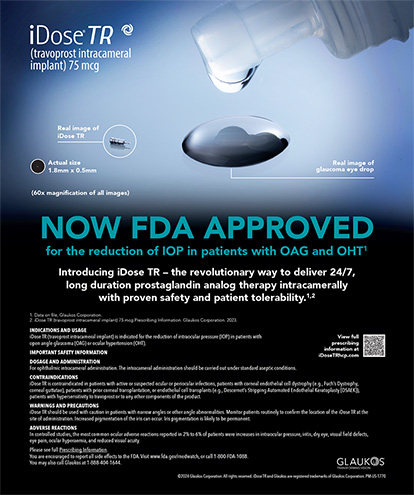Film and video have been used in medical education almost since these media became available. In fact, ophthalmologists appear to be some of these technologies' earliest adopters, as evidenced by the excellent film shot in 1917 of Professor Jos? Barraquer performing intracapsular cataract surgery with the "erisophake" or miniature vacuum extractor (Figure 1). The use of film in medicine did not become widespread, however, until the mid-to-late 20th century. In 1951, Sir Harold Ridley filmed his pioneering lens implantation procedure in color (Figure 2).
The first serious effort to record, archive, and disseminate video footage of ophthalmic surgery was the Video Journal of Cataract and Refractive Surgery, first produced in 1985 by Robert Osher, MD (www.vjcrs.com; also now available at www.eyetube.net). This journal is a rich source of surgical techniques and innovations with contributions from a wide international fraternity of surgeons (Figure 3).
Digital recording and resolution have changed the way that most of us conduct our daily lives. The equipment has become readily accessible and affordable, and the quality of images and ability to archive them are outstanding. Digital video editing has also eliminated many of the technical barriers to the average user.
The idea behind The Video Atlas of Eye Surgery was to produce a comprehensive, high-quality educational resource with a strong emphasis on timeless, basic principles as well as their practical application. The goal was to systematically cover routine surgery in a manner suitable for training residents and also to cover the management of challenging cases and complications for more advanced surgeons.
HOW THE ATLAS CAME TO BE
Impetus
Now that digital video has become mainstream, there is an almost inexhaustible supply of ophthalmic movies on clinical and surgical procedures available on the Internet. Many scientific journals and professional organizations publish peer-reviewed video on their Web sites. For example, the AAO (one.aao.org/ce/default.aspx), the ASCRS (ascrs2007.conferencefilms.com), and the British Journal of Ophthalmology (bjo.bmj.com/video/collection.dtl) all publish video material. Other Web sites offer podcasts and videos, including Eyetube.net from the publishers of Cataract & Refractive Surgery Today and the on-demand multimedia service of the European Society of Cataract & Refractive Surgeons (www.escrs.org). In the public domain, YouTube (www.youtube.com) has thousands of movies on cataract and refractive surgery, made by both surgeons (often as a marketing tool) and patients (as a personal testimonial). Even iTunes (Apple Inc., Cupertino, CA) is a resource for movies and podcasts in ophthalmology.
Paradoxically, the stripping away of superficial barriers to the average person's production of movies has exposed a greater underlying challenge: the task of creating an exceptional movie that is visually engaging, has gripping momentum and compelling narrative, and delivers a tangible impact at a suitable pace.
This challenge led a few years ago to the development of a comprehensive video-based training program: The Video Atlas of Eye Surgery.
EXECUTION
In an effort to provide a well-balanced perspective independent of individual egos, the contributions to The Video Atlas are a collaborative endeavor between an international group of experienced ophthalmologists with reputations as committed and experienced educators. The goal was to provide a comprehensive training resource for both learning and teaching eye surgery. Additionally, my colleagues and I wanted to structure the content to make it suitable for integration into postgraduate training programs.
The concept of The Video Atlas evolved against the backdrop of a changing environment of postgraduate medical education. For many institutions, the traditional one-on-one apprenticeship has become difficult to sustain. All are now faced with the challenge of maintaining a high standard of training of sufficient breadth and depth in spite of diminishing time and resources. Out of necessity, teachers have developed innovative educational tools and techniques that are efficient and effective. The Video Atlas is one example.
CONTENT
Throughout the production of The Video Atlas, my colleagues and I have used digital video clips of the highest quality and selected the best of them from an archive of thousands of hours of footage purposefully filmed over many years. For example, in the DVD on basic techniques in vitreoretinal surgery, we used only 2 of 600 hours of footage that had been specifically recorded for this project.
We have taken this source material, combined it with custom-built graphics and 3D animations, and then edited the material with carefully scripted voiceovers. The end product is a highly structured educational package entirely composed of professionally produced, self-contained movies.
These high editorial standards mean that the production of The Video Atlas is a long, slow effort. We hope and believe, however, that the end result will be worth the work.
SUPPORTING OPHTHALMOLOGY IN THE DEVELOPING WORLD
The Video Atlas is published independently through Eye Movies Ltd. (Surrey, United Kingdom) for two reasons. First, the authors retain full control over the quality of production. Second, the principal motivation of our contributing authors is not financial. The primary incentive is that this project represents a balanced and comprehensive distillation of procedures that the authors have successfully employed, often helped to develop, and wish to share for the training of future ophthalmologists worldwide. To this end, the publishers contribute both through donations from sales of The Video Atlas and through the provision of the free licensing of training videos to organizations within Vision 2020: the Right to Sight, a global initiative to eliminate blindness (www.v2020.org). In this manner, the production of similar training programs can be supported pro bono for the developing world.
Editor's note: To find out more about this project, visit www.eyemovies.co.uk (Figure 4).
Brian Little BSc, MA, FHEA, FRCS, FRCOphth, is Consultant Ophthalmologist and Honorary Senior Lecturer at the Royal Free Hospital NHS Trust in London. Dr. Little is Medical Director and Series Editor of The Video Atlas of Eye Surgery (no remuneration) and receives royalties from the sales of his movies pro rata with other co-authors. Dr. Little may be reached at 011 0044 207 830 2208; eye.surgeon@mac.com.


